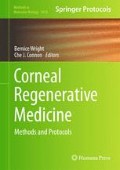Abstract
The unambiguous identification of limbal epithelial stem cells is currently a major challenge in corneal stem cell biology. Specific molecular markers which characterize these cells are lacking. At present, the best strategy for identification of limbal epithelial stem cells is to investigate a variety of putative markers for these cells in a differentiated (cytokeratin (CK) 3: CK3, integrin α6), undifferentiated (CK14), and naive state (∆Np63α, ATP-binding cassette subfamily G member 2 (ABCG2), integrin α9, Notch-1), alongside functional assays which indicate their stemness. The focus of this chapter is to highlight advances in the Western blotting technique for quantitative assessment of corneal epithelial cell markers, and the use of this technique for investigation of a range of different protein markers which identify limbal epithelial stem cells.
Access this chapter
Tax calculation will be finalised at checkout
Purchases are for personal use only
References
Li W, Hayashida Y, Chen YT, Tseng SC (2007) Niche regulation of epithelial stem cells at the limbus. Cell Res 17:26–36
Davanger M, Evensen A (1971) Role of the pericorneal papillary structure in renewal of corneal epithelium. Nature 229:560–561
Kulkarni BB, Tighe PJ, Mohammed I, Yeung AM, Powe DG, Hopkinson A et al (2010) Comparative transcriptional profiling of the limbal epithelial crypt demonstrates its putative stem cell niche characteristics. BMC Genomics 11:526
Majo F, Rochat A, Nicolas M, Jaoudé GA, Barrandon Y (2008) Oligopotent stem cells are distributed throughout the mammalian ocular surface. Nature 456:250–254
Schlotzer-Schrehardt U, Kruse FE (2005) Identification and characterisation of limbal stem cells. Exp Eye Res 81:247–264
Schermer A, Galvin S, Sun TT (1986) Differentiation-related expression of a major 64 K corneal keratin in vivo and in culture suggests limbal location of corneal epithelial stem cells. J Cell Biol 103:49–62
Chen Z, de Paiva CS, Luo L, Kretzer FL, Pflugfelder SC, Li DQ (2004) Chara-cterization of putative stem cell phenotype in human limbal epithelia. Stem Cells 22:355–366
Higa K, Shimmura S, Miyashita H, Kato N, Ogawa Y, Kawakita T et al (2009) N-cadherin in the maintenance of human corneal limbal epithelial progenitor cells in vitro. Invest Ophthalmol Vis Sci 50:4640–4645
Nakatsu MN, Ding Z, Ng MY, Truong TT, Yu F, Deng SX (2011) Wnt/β-catenin signaling regulates proliferation of human cornea epithelial stem/progenitor cells. Invest Ophthalmol Vis Sci 52:4734–4741
Truong TT, Huynh K, Nakatsu MN, Deng SX (2011) SSEA4 is a potential negative marker for the enrichment of human corneal epithelial stem/progenitor cells. Invest Ophthalmol Vis Sci 52:6315–6320
Thomas PB, Liu YH, Zhuang FF, Selvam S, Song SW, Smith RE et al (2007) Identification of Notch-1 expression in the limbal basal epithelium. Mol Vis 13:337–344
Zhou SY, Zhang C, Baradaran E, Chuck RS (2010) Human corneal basal epithelial cells express an embryonic stem cell marker OCT4. Curr Eye Res 35:978–985
Chen B, Mi S, Wright B, Connon CJ (2010) Investigation of K14/K5 as a stem cell marker in the limbal region of the bovine cornea. PLoS One 5:e13192
Notara M, Alatza A, Gilfillan J, Harris AR, Levis AR, Schrader S et al (2010) In sickness and in health: corneal epithelial stem cell biology, pathology and therapy. Exp Eye Res 90:188–195
Colabelli Gisoldi RA, Pocobelli A, Villani CM, Amato D, Pellegrini G (2010) Evaluation of molecular markers in corneal regeneration by means of autologous cultures of limbal cells and keratoplasty. Cornea 29(7):715–722
Shortt AJ, Secker GA, Rajan MS, Meligonis G, Dart JK, Tuft SJ et al (2008) Ex vivo expansion and transplantation of limbal epithelial stem cells. Ophthalmology 115:1989–1997
Harkin DG, Barnard Z, Gillies P, Ainscough SL, Apel AJ (2004) Analysis of p63 and cytokeratin expression in a cultivated limbal autograft used in the treatment of limbal stem cell deficiency. Br J Ophthalmol 88:1154–1158
Rama P, Bonini S, Lambiase A, Golisano O, Paterna P, De Luca M et al (2001) Autologous fibrin-cultured limbal stem cells permanently restore the corneal surface of patients with total limbal stem cell deficiency. Transplantation 72:1478–1485
Kenyon KR, Tseng SC (1989) Limbal autograft transplantation for ocular surface disorders. Ophthalmology 96:709–722
Utheim TP, Raeder S, Utheim OA, Cai Y, Roald B, Drolsum L et al (2007) A novel method for preserving cultured limbal epithelial cells. Br J Ophthalmol 91:797–800
Kurien BT, Scofield RH (2006) Western blotting. Methods 38:283–293
Lowry OH, Rosebrough NJ, Farr AL, Randall RJ (1951) Protein measurement with the Folin phenol reagent. J Biol Chem 193:265–275
Hames BD (ed) (1998) Gel electrophoresis of proteins—a practical approach, 3rd edn. Oxford University Press, Oxford, UK
Mathews ST, Plaisance EP, Kim T (2009) Imaging systems for westerns: chemiluminescence vs. infrared detection. Methods Mol Biol 536:499–513
Acknowledgment
This work was funded by the Medical Research Council (MRC).
Author information
Authors and Affiliations
Editor information
Editors and Affiliations
Rights and permissions
Copyright information
© 2013 Springer Science+Business Media New York
About this protocol
Cite this protocol
Wright, B., Connon, C.J. (2013). Limbal Epithelial Stem Cell Identification Using Immunoblotting Analysis. In: Wright, B., Connon, C. (eds) Corneal Regenerative Medicine. Methods in Molecular Biology, vol 1014. Humana Press, Totowa, NJ. https://doi.org/10.1007/978-1-62703-432-6_6
Download citation
DOI: https://doi.org/10.1007/978-1-62703-432-6_6
Published:
Publisher Name: Humana Press, Totowa, NJ
Print ISBN: 978-1-62703-431-9
Online ISBN: 978-1-62703-432-6
eBook Packages: Springer Protocols

